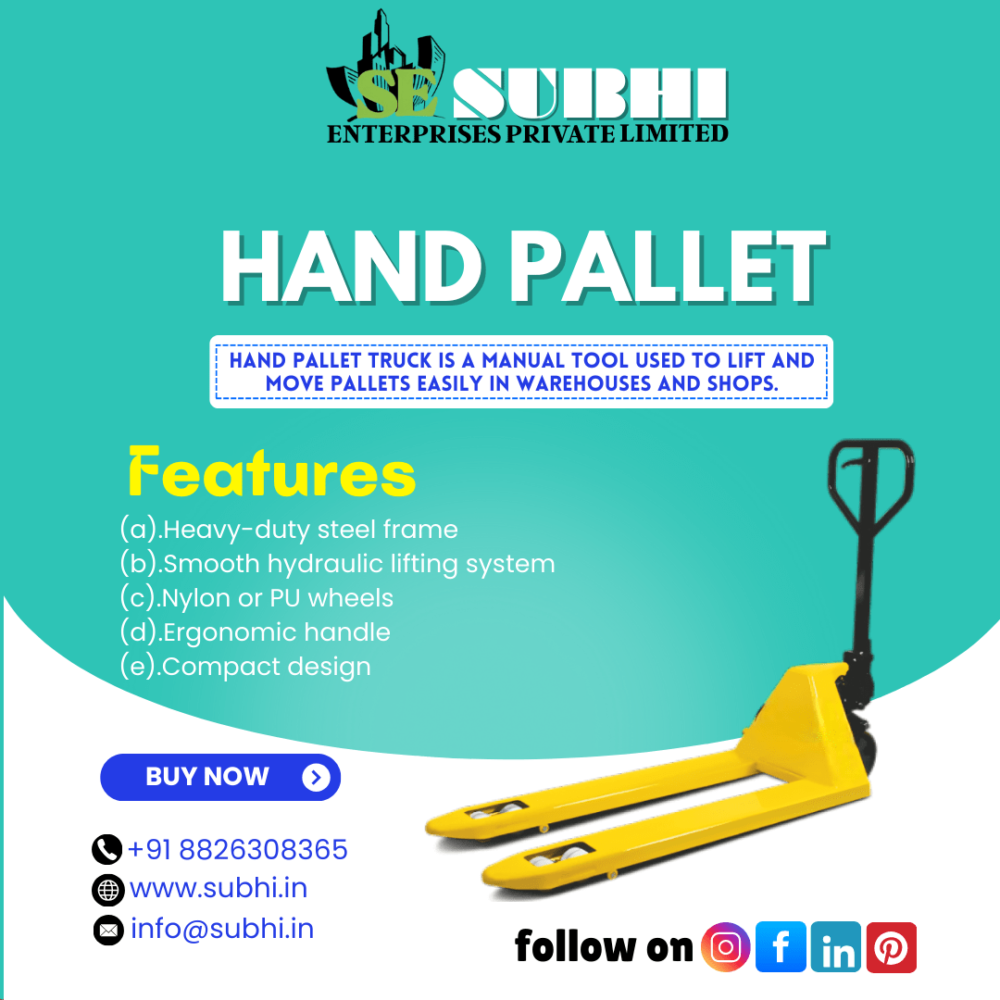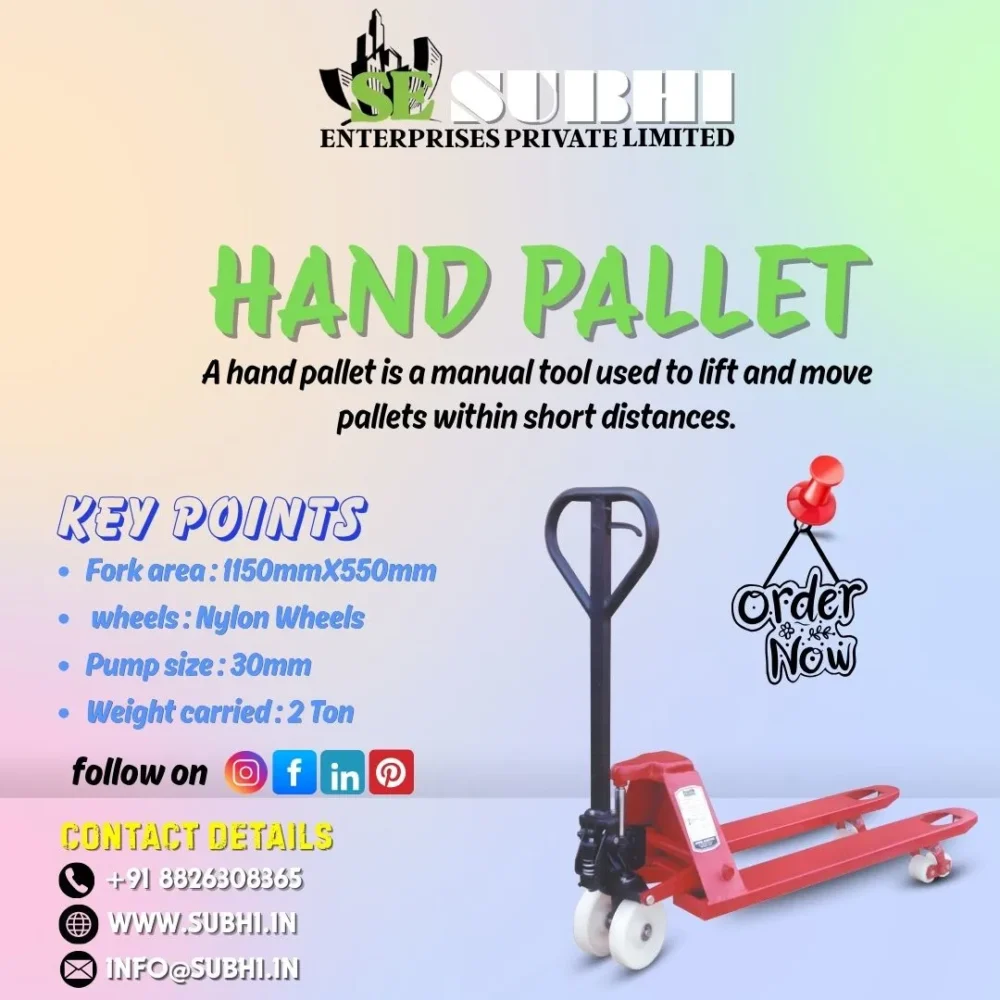With the frenetic pace of today’s logistics and warehousing business, speed, safety, and efficiency are the Mantra. While forklifts get all the attention, there is a workhorse in the background, going about the heavy duty, literally. The humble hand pallet truck, or pallet jack, has been a warehouse, retail shop, and factory staple for decades.
In this blog, we’ll explore what hand pallet trucks are, how they work, why they’re still indispensable despite advances in automation, and how to choose and maintain the right one for your needs.
What Is a Hand Pallet Truck?
A hand pallet truck is a simple, manual device that’s used to pick up and move pallets within a building. It’s designed to be capable of handling the regular-sized pallets and can be driven by a single person. Hand pallet trucks require no fuel, or recharging, or extensive maintenance, unlike electric pallet jacks, or gas forklifts.
They comprise these parts:
(a). Forks : The two metal handles that slide under a pallet.
(b). Hydraulic pump handle : For raising the forks by hand pumping.
(c). Wheels : Small polyurethane or nylon wheels at the bottom of the forks and steering handle to ride smoothly.
(d). Control handle : A lever on the handle to raise, lower, or lock the forks.
A Short History of the Pallet Truck
Pallet Truck’s early history can be traced to the early 20th century. With global trade and industrialization growing, there was a need for an enhanced system for easy movement of goods in factories and shipping warehouses. The modern wood pallet was developed during the 1920s and soon, there was a need for machinery to handle these heavy flat wooden structures.
The earliest versions of pallet trucks were primitive – indeed just two forks with wheels – but advancements in hydraulics developed it into what we know today. Further developments in materials, ergonomics, ease of maneuvering, and other factors ensured that they became relevant to almost every situation turnover handling was required.
Why Are Hand Pallet Trucks Still Relevant?
If you relate to the concern in an automated world dominated by high-tech solutions like why manual pallet trucks still exist; it is for the obvious reasons of saving money, dependability, and uncomplicated operation.
1. Saving Money
Electric pallet jacks and forklifts, apart from needing electric power, can cost thousands of dollars. On the contrary, a high-quality hand pallet truck costs 200 to 700 dollars. This makes a huge difference for smaller operations or companies that run on thin margins.
2. No Power Source Needed
There are no batteries or fuel needed for hand pallet trucks. This is especially beneficial for businesses that do not want to deal with charging stations or battery replacement.
3. Compact and Highly Mobile
The small dimensions of these trucks allow for movement into restricted turns, busy spaces, and narrow aisles where forklifts might get stuck. They are perfect for retail environments, small warehouses, delivery vehicles, and storage areas.
4. Maintenance Free
Due to the lack of electronics and minimal moving pieces, hand pallet trucks are easy to keep in good condition. They often require nothing more than a bit of grease and an occasional inspection.

Different Types of Hand Pallet Trucks
With the variation of operations, not every hand pallet truck is the same. You may need a specific type of truck for your business:
1. Standard Pallet Truck
This is the most standard version of a pallet truck. It is designed to lift Euro pallets or regular-sized pallets. It’s great for warehousing.
2. Low Profile Pallet Truck
These are designed for pallets with low clearance. The forks are set lower than the standard model.
3. Wide or Narrow Pallet Trucks
These are designed for Non-Standard Pallets. If your facility uses custom pallets, you may require wider or narrower fork spacing.
4. Stainless Steel Pallet Truck
These trucks are perfect for food, pharmaceuticals, or chemical processes, as they need a high level of cleanliness and resistance to corrosion.
5. High Lift Pallet Truck
These trucks are still manually driven, but they can lift pallets higher – usually to waist height. Very useful for loading and unloading operations that require ergonomic positioning.
How to Safely Operate a Hand Pallet Truck
As easy as they are to operate, safe use requires following best practices.
Step-by-Step Procedure
(a). Inspect Wheels and Forks : Check for any damage or excessive wear on the wheels, forks, and wheels of the hydraulic unit.
(b). Fork Positioning : Glue the forks to the bottom of the pallet till they’re totally inserted.
(c). Pallet Lifting : Using the hydraulic lever, raise the pallet off the floor.
(d). Load Transportation : Only transport the pallet jack while facing forward towards its handle and pull it towards yourself. You are only permitted to turn around if in a congested area.
(e). Pallete Level Adjustment : Use the control lever to lower the forks at a steady pace.
Safety
(i). Do not exceed the limit of set weight capacity (roughly between 2,000–5,500 lbs).
(ii). You’re prohibited to driving the pallet truck over slopes.
(iii). Operating the pallet truck while standing on it or carrying any people is strictly prohibited.
(iv). Never position hands or feet near moving parts.
(v). While proper training may seem overly cautious with such it being such a simple tool, manual equipment poses a risk for strain injuries and accidents.
Selecting the Right Hand Pallet Truck

Purchasing a hand pallet truck is not as easy as taking the cheapest one you can find online. You must take into account the following considerations:
1. Load Capacity
Ensure that the truck can bear your heaviest normal loads. Most trucks can bear 2,500 to 5,500 lbs. Overloading them can damage both the truck and the pallet.
2. Fork Size
Standard forks are 48 inches long and 27 inches wide, but if working with non-standard pallets, be certain to measure accordingly.
3. Wheel Type
For smooth surfaces, polyurethane wheels are most appropriate.
Nylon wheels endure heavy loads and rougher surfaces better.
Good traction is provided with rubber wheels along with quiet operation; however, they tend to wear out faster.
4. Environment
Will you operate in cold storage, damp situations, or sterile clean room environments?
Stainless steel or galvanized pallet trucks will be necessary for hygiene or corrosion resistance.
Keeping Your Hand Pallet Truck in Good Shape
Remember that low-maintenance doesn’t mean no maintenance. Regular upkeep will extend the life of your pallet truck while ensuring employee safety.
Monthly Maintenance To Do’s
(a). Check wheel rotation for debris and any signs of wear such as flat areas.
(b). Add grease to the axle and pivot joints.
(c). Look for any signs of leaks in the hydraulic system.
(d). Remove any excessively loose bolts or fasteners.
(e). Check if lifting or lowering the handles is smooth.
Releasing trapped air in the hydraulic system or replacing seals might be needed if the handle feels spongy or the truck does not lift smoothly.
Practical Implementations
Lets examine the areas where the impact of hand pallet trucks is most significant, starting from:
(a). Retail : Putting away boxes or moving them into storage in warehouse storerooms.
(b). Warehousing : Picking and staging orders within the minimum time possible.
(c). Manufacturing : Moving materials between workstations.
(d). Truck Loading/Unloading : Works best in box trucks with restricted room.
(e). Farms & Greenhouses : Effortlessly manages soil, fertilizers, and fresh produce.
Conclusion
It is fairly obvious in the case of the hand pallet truck that despite its plain design, or lack of features, it has great practicality. Businesses that work with limited resources will learn to appreciate highly its use in increasing productivity.Lines of production that operate on strict budgets will come to appreciate the efficiency it gives.
Given the simplicity with which these devices manage operational costs, combined with the other benefits they provide, the pallet truck reaffirms its title as the premier tool of material handling. Whether one runs a retail business or operates a distribution center, the purchase of a quality hand pallet truck is one of the most worthwhile investments to make.
Whether you are contemplating the purchase of new pallet trucks or looking to upgrade your existing ones, taking the time to train your staff, maintaining your equipment, and most importantly, choosing the right type of equipment is critical for your smooth and safe operations for years to come.
